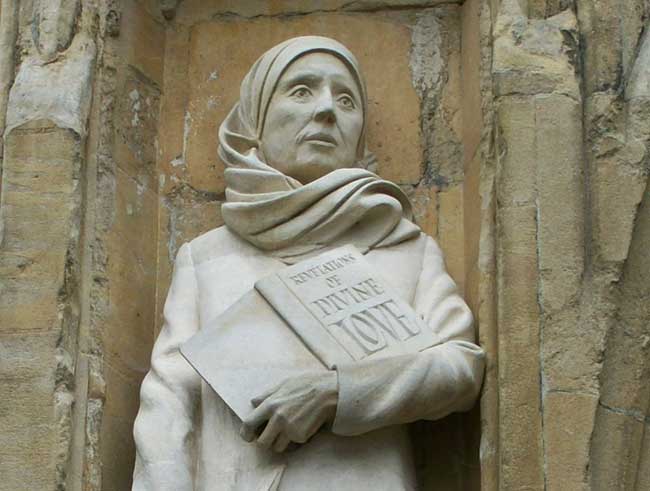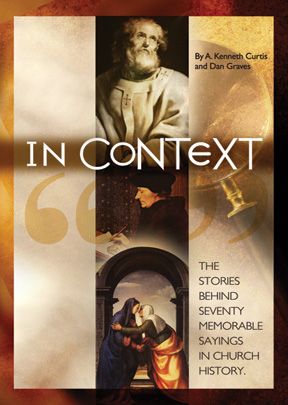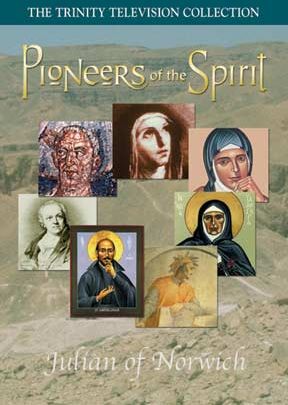"DYING" JULIAN SPOKE WITH CHRIST IN VISIONS

[Above: Statue of Julian of Norwich by David Holgate, west front, Norwich Cathedral—Poliphilo / [CC0 1.0] Wikimedia File:Statue of Dame Julian.JPG]
JULIAN, A NOTABLE MYSTIC, was born in Norwich about 1342, shortly before the Black Death ravaged England. She was about six when the plague swept through Norwich with all its terrors. The frightful cries of misery, the haunting scenes of despair and death, the panic of the populace, and the perplexing mystery of God’s dealings with mankind seem to have turned her thoughts to God’s purposes and her own spiritual inadequacy to face death. At any rate, sometime in her early years she felt a lack within herself and asked God for three gifts.
The first was the “mind” of Christ’s passion. The second was “bodily sickness in youth at thirty years of age,” by which she meant going through all that a dying person experiences short of death itself. The third was to receive three wounds: true contrition, heartfelt compassion, and purposeful love for God. However, she later admitted she forgot about the first two requests.
Despite her forgetfulness, she considered that God remembered what she had asked because on this day, 8 May 1373, when she was thirty and a half years old, her petitions were granted. She became seriously ill. Everyone thought she was dying. On 12 May, the last rites were administered and she continued to decline. Three days later, those attending her thought she actually had died. She herself reported difficulty breathing and numbness from the waist down.
A priest came to be with her in her final moments. The boy with him held a crucifix before her eyes, then set it at the foot of the bed. The priest commanded her to look at the cross. She did not want to, because it meant she had to change the position of her upper body, which was painful for her. However, she obeyed. Soon the numbness spread to her chest and arms and she could no longer lift her hands. She gasped for air and her heart beat erratically.
Suddenly, as she stared at the cross, all her pain was gone and her body was completely whole, especially the upper half. It occurred to her to ask to have Christ’s wounds (the stigmata). In this state of mind, she experienced a vision. It began when she saw blood flow down from under the crown of thorns on the crucifix. Christ seemed alive on that cross. The Trinity filled her heart with joy. She saw Mary and understood her obedience and reverence for God. And Julian heard Christ speak. He showed her a little thing about the size of a hazelnut and, in answer to her questions, told her it was everything he had made; it would last forever because of his love.
Thus began the first of fifteen “shewings” or revelations granted her that day and a sixteenth the following morning. After her recovery she wrote or dictated these visions in short form. Then, for the next twenty years she mulled them and teased out their meaning. Finally she wrote a longer text amplifying the insights she had gained in those years of meditation.
These books are the first known writings of an English woman. Some scholars consider the longer version of the Shewings a work of systematic theology. It is not rigorous scholastic theology with propositions and proofs, but an attempt at eliciting self-consistent answers to theological questions based on what she had seen. She dealt with the origin and nature of sin, God’s love, human predestination, the problem of pain, and other difficulties.
Central to her revelations was the love that drove Christ to suffer for us. She saw this as the whole explanation for history and the great expectation of heaven. “Me liked none other heaven than Jesus, which shall be my bliss when I come there.”
When she wondered why sin had been allowed to happen, she was merely told it was “behovable,” that is, necessary but hinged on other events. Her visionary Christ also promised her that all would be well. When she wondered how such wellness is possible when the church (based on Scripture) teaches that many souls will be lost, she got the reply, “I shall save my word in all things, and I shall make all thing well.”
Denys Turner sums up Julian’s theology as supposing
a God who wills in a single act of love, a single unbroken solidarity with creation so intimate as to have been unachievable in any other way than one: by sharing not in the sin but in the interim price, which is ‘sin’s sharpe pain’ in life, then in its final down payment, which is death.
During her later years, Julian lived as an anchorite (hermit) in a cell attached to Norwich’s old church of St. Julian (from which it is thought she took her name). The present church was rebuilt after World War II.
Since Julian said little about herself in her Revelations of Divine Love, we are indebted to Margery Kempe for most of our limited knowledge of her. Margery made a pilgrimage to see “Dame Julian” around 1414 to seek reassurance from her. Julian died a few years after Margery’s visit, probably in 1416.
—Dan Graves
----- ----- -----
For a deeper look at Julian, read our assessment of her quote, “All shall be well, and all manner of thing shall be well” in In Context
and read "A little thing like a nut" in Christian History #127, Medieval Lay Mystics
Finally take a look at the documentary, Pioneers Of The Spirit: Julian Of Norwich








